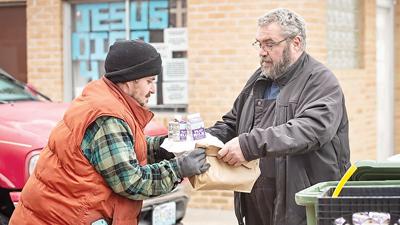This story is the first in a series that examines homelessness in Jefferson County. Homelessness appears to be on the rise because of a variety of factors. Homelessness touches law enforcement, health service agencies, housing providers and other county resource providers, which are trying to help this vulnerable population. The series will examine the problem, those involved in helping homeless people and possible solutions.
In December, two days before single-digit temperatures and dangerous subzero wind chills struck the area, the recently established nonprofit New Hope Outreach Center prepared a hot breakfast and coordinated the delivery of those meals, along with care packages, to 45 people at five homeless encampments scattered throughout the county. At one location hidden in the rolling hills behind a storefront off a busy highway, 20 homeless people hunkered down in tents, many fueled by propane heaters.
The people at those five encampments are just a part of the homeless population in Jefferson County. While many believe the number of homeless people in the county is growing, no one knows for sure how large the population is.
However, a group of volunteers will try this month to get a clearer picture of how many countians are homeless. The information they gather will provide much-needed data for those who want to help people who are homeless.
A Point-in-Time (PIT) count of homeless people in the county is set for Jan. 25. About 15 volunteers will be stationed at libraries, fire departments, Mercy Hospital Jefferson and areas where homeless people are known to stay so the volunteers can get a snapshot of the county’s homeless population on a single night.
Last year, the county’s annual PIT was taken Feb. 23 after the effort was delayed because of icy weather, and it counted 44 homeless people, including 29 sheltered and 15 unsheltered people. In 2021, the sheltered homeless numbered 14, and no unsheltered data was collected. In 2020, there were 41 homeless people, with 37 sheltered and four unsheltered people.
Jefferson County PIT organizer Karen Ferrell, housing manager for Comtrea, said the PIT count is a barometer for tracking changes in the number of homeless people, their demographics and needs. PIT counts typically are gathered nationwide the last week of January and are one of several factors tied to the U.S. Department of Housing and Urban Development’s (HUD) federal funding allocations to address homelessness.
“PIT is just a snapshot that helps to identify people who would be homeless if not sheltered,” Ferrell said. “The problem is that a lot of homeless people don’t want to be found that night or anytime. We get an average of 40 phone calls a week from new families and new individuals who identify themselves as homeless. Probably 60 percent are living on someone else’s couch and are relying on someone else to support them.”
The actual number of homeless people in the county may be significantly higher than the PIT counts reflect, according to the Jefferson County Sheriff’s Office, social agencies and organizations that provide services to people who are experiencing homelessness. Those agencies struggle to help a largely invisible homeless population that has no emergency or transitional shelter and limited public transportation to resources.
“Those who work with the homeless day in and day out realize that homelessness is a much larger crisis than what those counts convey,” said Sue Curfman, president and CEO of Comtrea. “It (the PIT) s simply a point in time, and no way does it account for the magnitude of the problem.”
A familiar face at the encampments, Cpl. Drew Crews, who leads the Sheriff’s Office Homeless Outreach Team, has been tasked with identifying the number of homeless people in Jefferson County and resources available to them. Through early December 2022, the Homeless Outreach Team had located 120 homeless people – 64 men, 47 women and nine children – from over 225 referrals.
That included 69 people who were living outdoors unsheltered, 19 people housed in hotels paid for by a third party, and 32 people living in their car or other place not intended as a sleeping accommodation. About one-third reported being diagnosed with mental health issues, and slightly more than one-third were admitted drug users. About 60 percent had a criminal record.
The Sheriff’s Office Crisis Intervention Team, which includes two licensed mental health counselors, often joins the Outreach Team to visit homeless people to assess and evaluate their well-being.
Referrals tend to wax and wane along with temperature extremes, Crews said.
“One day in early December, I received six referrals in five minutes,” he said. “We offer a hand up, not a hand out. I try to find out what they need and get it for them.
“The number of homeless people we’ve had contact with is significant because we know that most homeless people and camps in rural areas are never discovered. They try to stay hidden in the shadows. You see them standing at street corners asking for money or riding their bikes along the highway, but other than that they do their best to stay invisible.”
Homelessness also impacts students whose families may have lost their housing due to a job loss or other circumstance. Some students leave their homes unaccompanied due to violent or stressful home situations. The Fox C-6 School District, with 10,500 students, has helped 54 homeless students and 34 unaccompanied youth thus far this year, said Kim Loomis, director of federal programs.
“These students live with grandparents, neighbors or friends,” Loomis said. “We provide support to unaccompanied youth with monthly contacts from our social workers and counselors to ensure students have what they need to be academically successful and prepare for opportunities after high school.”
The Hillsboro R-3 School District, with 3,285 students, has had 20 homeless students and 18 unaccompanied youth this year, assistant superintendent Melissa Hildebrand said.
The Northwest R-1 School District, with 5,993 students, has had 71 homeless students and 15 doubled up or unaccompanied students, district spokesman Chuck McPherson said.
In 2022, the two-officer Homeless Outreach Team received $300,000 in funding from Jefferson County’s American Rescue Plan Act (ARPA) monies to aid public health and economic recovery from the COVID-19 pandemic. Crews was allocated $150,000 from those funds for 2023 for his work with the homeless.
“The County Council wanted to better understand the issue of homelessness,” Sheriff Dave Marshak said. “At the same time, the Sheriff’s Office was getting an increase in complaints from citizens because homeless people had become more visible, and they were concerned about their quality of life.”
County Executive Dennis Gannon said a Homeless Coalition is working hard on this problem.
“Their grassroots approach is important,” he said. “I encourage those efforts to continue. I believe there are several reasons for a person being homeless. While we do not have all the answers of how to fix the problem, I do know that this does not mean we can’t help make life better for homeless people.”
Through its efforts, the Jefferson County Health Department, along with about a dozen partner organizations, has reached nearly 425 homeless people and people at-risk of becoming homeless via its quarterly Homeless and Essential Needs Outreach events. Begun in December 2021, the events have been held in Arnold, Cedar Hill, De Soto and Festus, organizer Jillian Bissell said.
The events have provided those in need with resource kits, clothing, sleeping bags and tents, as well as medical and dental services through the Health Department’s mobile medical and dental vans.
The largest annual outreach event in the county, Project Homeless Connect, was held in September at The Peace Pantry in Cedar Hill, with about 30 agencies on hand. Attended by 101 people, it was essentially “a one-stop shop,” said Ferrell, the organizer.
In addition, 188 people drove through a food distribution that was held at the same time, she said.
New Hope Fellowship Church of High Ridge crisscrossed the county transporting people in shuttles to Project Homeless Connect.
Comtrea, which provides health services throughout the county, served 382 homeless people in 2022, providing primary care, dental and psychiatric services, Curfman said.
“This does not include the behavioral health subset in which case management, substance use and mental health services were provided through our certified community behavioral health organization,” she said.
Curfman recalled arriving for work at the Comtrea office in Arnold early one morning in November to find a man sitting on a bench with everything he owned: a tote, three plastic bags and his dog.
“He had been dropped off there by EMS (emergency medical services) responders. It had been 40 degrees that night, and he was wearing a T-shirt and had wrapped his dog in a blanket,” Curfman said. “He self-reported as being homeless and explained that his rent had gone up more than 50 percent. He could not afford to pay the rent even with full disability and food stamps, so he and his dog had been evicted. His plight is the plight of many all over the county.”
A myriad of causes can lead to homelessness, and while each case is different, Curfman attributed the main drivers of homelessness in the county to a lack of affordable housing, inflation, the long wait for housing support, and mental health and substance use issues.
“The sad part is that when you look at the statistics, more than 50 percent of us are one paycheck away from being homeless,” Curfman said. “If you suddenly don’t have a steady supply of food and are always hungry and cold because you don’t have a warm shelter, that can create mental stress. If you don’t take care of those basic needs before addressing mental health, it’s just upside down.”
The shortage of affordable housing in the county is an issue of far greater demand than the supply. Additionally, while emergency rental assistance helped to prevent eviction during the pandemic, it has been lifted and left many people vulnerable.
“I often encounter homeless people with rent vouchers and nowhere to go,” Crews said.
With the long-range weather forecast in the county calling for colder than normal temperatures, with frigid temperatures and snowstorms expected through February, that’s a terrifying forecast for countians who are homeless.
Click through to see all stories in this series related to homelessness in Jefferson County:
Click through to see all three stories in this series related to homelessness in Jefferson County.






